Video Cards
Last Updated: July 18, 2007
Tom's Hardware has a monthly article about the best gaming video card for the money (February 2011).
This rest of this section is a year old and desperately needs to be updated.
These cards were given high ratings on NewEgg.com by people who own them. While fast video cards are nice, these cards also give people the fewest number of problems, which you can't find on Tom's Hardware VGA {Performance} Chart. Both of these links include video cards that use the older AGP bus that I don't cover below.
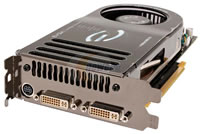 |
Today's Best Choice: Under $450, PCI-e, DirectX 10, HDReVGA 640-P2-N821-AR GeForce 8800GTS PCI-e x16 640MB SLI ready 96 pixel pipeline DirectX 9 OpenGL 2.0 Dual dual-link DVI (supports two 30 inch monitors) 128-bit HDR Microsoft Vista ready Read owner reviews at NewEgg.com (over 720 reviews, 5/5 stars). Buy it for $395. |
 |
Today's Best Choice: Under $300, PCI-e, DirectX 10, with cooling faneVGA 320-P2-N811-AR GeForce 8800GTS PCI-e x16 320MB SLI ready 96 pixel pipeline DirectX 10 OpenGL 2.0 Dual dual-link DVI (supports two 30 inch monitors) Microsoft Vista ready Read owner reviews at NewEgg.com (over 350 reviews, 5/5 stars). Buy it for $285. |
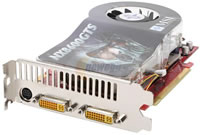 |
Today's Best Choice: Under $200, PCI-e, DirectX 10, with cooling fanMSI NX8600GTS-T2D256E OC GeForce 8600GTS PCI-e x16 256MB SLI ready pixel pipeline DirectX 10 OpenGL 2.0 Dual-link DVI (supports single 30 inch monitor) Microsoft Vista ready Read owner reviews at NewEgg.com (80 reviews, 5/5 stars). Buy it for $170. |
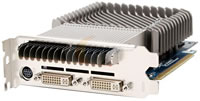 |
Today's Best Choice: Under $200, PCI-e, DirectX 10, no cooling fanGigabyte GV-NX86S256H GeForce 8600GTS PCI-e x16 256MB SLI ready 32 pixel pipeline DirectX 10 OpenGL 2.0 Dual-link DVI (supports single 30 inch monitor) Microsoft Vista ready Read owner reviews at NewEgg.com (17 reviews, 5/5 stars). Buy it for $190. |
 |
Similar to What Dell Sells - Good, But Not For GamesRadeon X1300 Pro PCI-e x16 256MB not SLI ready 4 pixel pipeline DirectX 9 OpenGL 2.0 Microsoft Vista ready Buy it for $110. |
Photos courtesy of NewEgg.com.
What to Look for in a Video Card
There is a direct correlation between speed and price. The fast ones are expensive and the slow ones are cheap.
The video card plugs into a slot on the motherboard. The slot is either one size for AGP video cards or another size for PCI-e video cards. Almost all new video cards use PCI-e. AGP is rapidly dying. PCI-e and PCI-e x16 all mean the same thing on this page.
Editing 1080i High Definition (HD) video may require video cards with 256MB of onboard RAM. 512MB cards aren't that common yet. Review the video editing software's system requirements.
The video cards with a fan can get as loud as a hair dryer while playing games. My GeForce 7600GT card is only loud during boot up and playing 3D photo-realistic games. It's very quiet the rest of the time, but not silent.
Windows Vista requires a more powerful video card than Windows XP to run Aero Glass. Vista also introduced DirectX 10 (DX10) for 3D photo-realistic games which offers more effects than DirectX 9.
Many video cards now require a specialized, 6-pin power plug. Make sure your power supply has one or you may need to get a new power supply.
If you are in the market for a 30 inch LCD monitor, verify the video card has a feature called "dual-link." The monitor requires a dual-link DVI cable to run from the monitor to the video card. This cable has more wires than the standard DVI cable. See a photo.
Relative Speeds
The list below ranks the video card models from fastest at the top to the slowest at the bottom for playing 3D, photo-realistic games per Tom's Hardware VGA Chart.
| Speed | nVidia GeForce | ATI Radeon |
| fastest | 8800 | |
/\ | | | \/ |
HD2900 | |
| X1950 | ||
| X1900 | ||
| 7900 | ||
| 7800 | ||
| 7600 | X1800 | |
| 6800 | ||
| X850 | ||
| X800 | ||
| 6600 | ||
| X700 | ||
| X1300 | ||
| X600 | ||
| 6200 | ||
| slowest | 5900 |
Features:
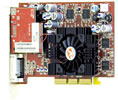 |
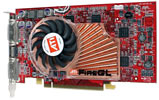 |
| AGP | PCI-e x16 |
AGP/PCI-e: These are the types of interfaces. The number of gold connectors at the bottom of the video card that plugs into the motherboard is different. PCI-e is faster and newer than AGP.
DirectX 10: This is Microsoft software that adds graphics features for more photo-realistic games. This is the most current version and is included with Windows Vista. DirectX 10 video cards appeared in June 2007.
DirectX 9: This is Microsoft software that adds graphics features for more photo-realistic games. Version 9 has been around since early 2003.
128MB, 256MB, 512MB: Video cards come with their own memory for faster performance. 32MB is enough for business applications and 256MB is the standard for people who love to play photo-realistic games and edit HD video. 512MB doesn't offer a speed boost - yet.
SLI: SLI allows two video cards to be connected together for a 30% boost in performance for games. A special motherboard is needed that includes two slots for video cards instead of just one ($80-$230).
HDR: High Dynamic Range (HDR) is a feature for games that makes them more life like and is used in Oblivion. Unfortunately, this feature is usually found on cards that cost more than $300. If you're a gamer and can afford it, then don't buy a card without it.

DVI/VGA: The monitor cable plugs into the computer into either one of these plugs. The white DVI plug is for a digital signal and the blue VGA plug is for an analog signal. LCD flat panel monitors can use either, depending on the model. CRT ("TV tube") monitors are analog only. The digital DVI plug offers a better image on the screen.
TV Tuner: Some video cards include a TV tuner to watch TV on your computer. The computer can also turn into a PVR like TiVo.
VIVO: Video In Video Out allow analog devices such as a TV, VCR, or analog video camera to connect to a computer and can capture and transfer video. Most video cards only transfer video out.
Video Card For Gamers
Serious gamers play 3-D photo-realistic games in high resolutions (1280×1024 or higher), 32-bit color, 60 frames per second, and with all of the special effects turned on. That requires the newest of video cards costing $250-$500.
Integrated Video Cards for Desktop Computers
Some motherboards have integrated video cards. They are usually found on low priced or small sized computers. The performance is substandard and they shouldn't be used for games or video. If a computer has "shared memory" or "shared RAM," then the video card is integrated into the motherboard.
Quieter Video Card Coolers
If you hate the noise on your video card and want to get a quieter cooler with a fan, then consider either Evercool Turbo 2 or Arctic Cooling Accelero X2. Tom's Hardware rated them the best in August 2006.
Notebook Video Cards
Notebook video cards are soldered into the motherboard and can't be upgraded. I don't like graphics cards that have shared memory as they are slow enough to hamstring a computer. Here is a quasi-ranking of the mobile chips with the newest and fastest chips listed on top. This list does NOT compare the speeds of Radeon video cards to GeForce video cards. It shows that out of all of the Radeon video cards, the X1800 is faster than the X1300. The same goes for the GeForce video cards. The GeForce Go 7800 is faster than the GeForce Go 6600. Tech ARP compiled a list of specs.
| ATI Model | nVidia Model | DirectX | DateReleased |
| GeForce Go 8600M | version 10 | May 2007 | |
| GeForce Go 8400M | version 10 | May 2007 | |
| Radeon X1800 | version 9 | Mar 2006 | |
| Radeon X1700 | version 9 | Sep 2006 | |
| Radeon X1600 | version 9 | Dec 2005 | |
| Radeon X1450 | version 9 | Sep 2006 | |
| Radeon X1400 | version 9 | Jan 2006 | |
| Radeon X1350 | version 9 | Sep 2006 | |
| Radeon X1300 | version 9 | Jan 2006 | |
| GeForce Go 7800 | version 9 | Jan 2006 | |
| GeForce Go 7600 | version 9 | Jan 2006 | |
| GeForce Go 7300 | version 9 | ||
| GeForce Go 6800 | version 9 | Jan 2005 | |
| GeForce Go 6600 | version 9 | Feb 2005 | |
| GeForce Go 6400 | version 9 | ||
| GeForce Go 6200 | version 9 | Jan 2005 | |
| Radeon X800 | version 9 | Sept 2004 | |
| Radeon 9800 | version 9 | Aug 2004 | |
| Radeon 9700 | GeForce FX Go5700 | version 9 | Feb 2004 |
| Radeon 9600 | GeForce FX5200, FX5600 | version 9 | June 2003 |
| Radeon 7000 | version 9 | Mar 2003 | |
| Radeon 9000 | GeForce4 Go | version 8 | Nov 2002 |
| Radeon 7500 | version 7 | Jan 2002 | |
| Rage Mobility | GeForce2 Go | Feb 2001 |
Dual Head Display
Almost all video cards allow two monitors to connect to a single computer to make one wide screen. I LOVE this feature. It saves me time by having two applications open full screen at once. I can have Quicken open in one screen and online banking open in the other. I can have an application open in one screen and the help file open on the other screen.
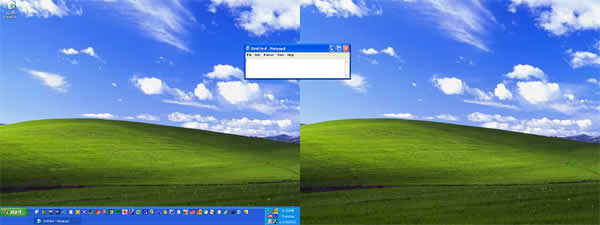
In the above example, NotePad is half on one monitor and half on the other monitor to show Windows treats it as one wide screen. It's fun to see people's reactions when I drag a window from one monitor to the next.
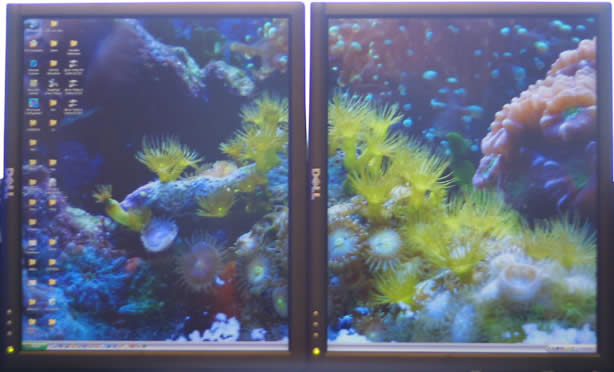
This is a nice setup for non-gaming activities: dual LCD flat panels in portrait mode. Normally, the same wallpaper appears on both monitors, but in this example, the video card driver (software) allows the wallpaper to cover both screens. Photo courtesy of FiringSquad.com.
Two to Six Panel LCD Display
CineMassive uses custom software and a custom LCD monitor stand to make two, three, four, five or six panel LCD arrays in a variety of different layouts and different sized screens. Unfortunately, they don't sell the software or LCD monitor stand separately. They cost about double of what the LCD monitors cost. If you're interested in this setup, please verify the video card requirements. Photo courtesy of Gizmodo.
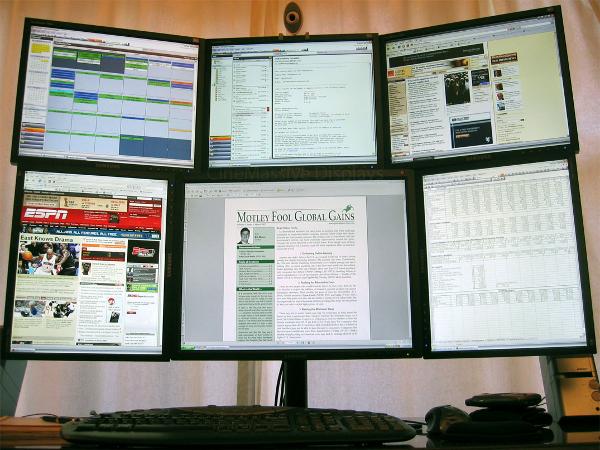
Top row: three 17 inch monitors in landscape. Bottom center: 20 inch 1600×1200. Bottom left and right: 17 inch in portrait mode.